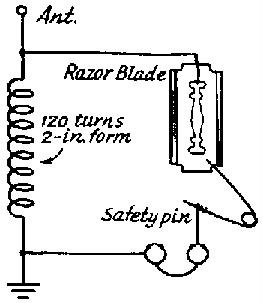
Note the simplicity of the above design. The parts are assembled on a piece of scrap wood, and tacked down. The safety pin is anchored at one end and placed so the point may be moved around on the surface of the razor blade. The blued steel surface of the blade gives the rectifying action replacing a crystal. later versions used a pencil lead point on the razor blade. The only part of a foxhole radio you don't build from scratch is the headphone. Some GIs used their bayonets buried to the hilt in moist earth for a ground connection!
In 1944, during WWI American and British troops in between millitary incursions, found themselves with a little extra time to fill. They missed radio. Thsi of courtse was well before the popularization of TV. Before CDs and 100 years before the Ipod. They wanted to hear music or news on the radio, but personal portable radios were strictly verboten [pun intentional] as the German millitary had radio detecting equipment that could detect certain radio receivers. Superheterodyne radios were just plan dangerous to a man in a foxhole.
At some point a resourceful American GI (probably a drafted engineering student) figured out that a simple radio receiver could be cobbled together from wires and other scrap. The first soldier that made the discovery is unknown. But at the time he was able to hear big band swing music and of course dangerous hypnotizing Axis propaganda! This soldier taught other soldier and it didnt take long to reach every beach head.
These small wireless sets were called "foxhole radios" by the press. It has been over sixty years since these first appeared. http://bizarrelabs.com/foxhole.htm
*diagram borrowed from the article "Foxhole Radios" by the ingenious Don Adamson
http://members.aol.com/djadamson7/articles/foxhole.html




No comments:
Post a Comment